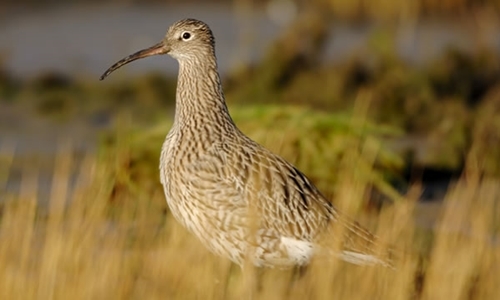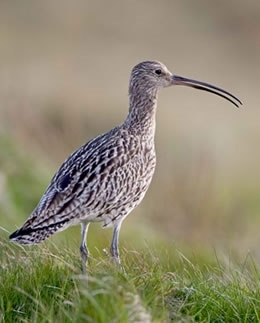By Mary Colwell – Lead producer for Saving Species, Shared Planet and Natural Histories on Radio 4
In many ways, the curlew seems an unremarkable bird. It is of no economic importance, we no longer eat it or use it as a source of down. Nor does it have stand out plumage, a crest or long tail feathers.
Predominantly brown and grey, some might say they are the frumpy, dowdy birds of muddy landscapes. They are also not classically attractive – a long nose, legs and neck fixed to a plump body are not the usual ingredients for beauty.

Yet somehow, curlew hold these characteristics with grace and elegance, our eye is drawn to them on coasts, estuaries, meadows and moorland. Combine a curlew’s physical characteristics with the evocative, fluty, trilling call that has inspired so much literature and music, and you have a bird that holds a special place in many hearts. They certainly do mine. And so it is with increasing alarm that I have watched the numbers of British curlew fall year on year.
The decline in curlew numbers
Over the last twenty years there has been a 97% decline in numbers in Ireland, 80% in Wales and on average over 50% throughout Scotland and England. The reasons are many and varied, differing from place to place, but there are a few standout causes.
As with many waders, the drainage of wet grassland and bog, increased fertilisation of agricultural land, the early cutting of grass for silage, afforestation and an increase in stocking density (in one study area around 33% of nest failures were due to trampling by sheep and cows,) all impact ground nesting birds that like rough, open, wet, undisturbed habitat for breeding.
Another major factor is predators, mainly foxes and crows. It now seems essential that if curlew are going to recover both habitat and predator control need to be tackled.
In 2015, ornithologist Tony Cross monitored twelve curlew nests in the Stiperstones area of Shropshire. Not one nest fledged young. Most were predated before hatching and of the nine chicks that did hatch, none made it to a month old. Foxes were the biggest factor, with badgers and crows as secondary causes.
Combined with an intensively managed landscape, mainly for sheep, the Shropshire curlew can find no place to nest and hide. In previous times, when numbers of curlew and lapwing were high and nesting near each other in loose colonies, they would band together to mob predators and drive them away.
Today, with numbers so low for both species, that simply isn’t possible and successful predation is far higher.
This is one study in one small area, but the same pattern is repeated time and again. In many places birds still arrive on breeding grounds but their breeding success is desperately low. Curlew are long lived, up to 30 years, and so we are seeing an ageing population that, in many areas, is not being replaced. The inevitable result is decline and local extinction.
 That said, it is not all bad news. In some areas curlews are doing well; the North Pennines and parts of northern England for example hold good curlew numbers that are breeding successfully, but for most of the British Isles, the future looks bleak. It is worth noting that the UK holds 25% of the breeding population of the Eurasian curlew.
That said, it is not all bad news. In some areas curlews are doing well; the North Pennines and parts of northern England for example hold good curlew numbers that are breeding successfully, but for most of the British Isles, the future looks bleak. It is worth noting that the UK holds 25% of the breeding population of the Eurasian curlew.
The poor curlew finds itself in the middle of many huge and increasingly problematic environmental issues. How much meat we eat (stocking density), climate change mitigation, economic development based on forestry and farming, even leisure pursuits, all impact. The future of curlew, and all British wildlife, depends on how we manage our complicated, crowded and highly managed landscape, and there are undoubtedly difficult decisions to make.
How we live alongside predators is a pressing problem, and one that needs consensus from politicians and the public if we are to hold onto a rich variety of wildlife. It is a fraught issue, provoking a great amount of emotion and heated debate.
Waders on keepered moors
There is no doubt that wading birds like curlew, lapwing and plover do very well on keepered moors where predators like foxes and crows, are held down. These areas do provide a refuge for birds that find surrounding areas increasingly unsuitable.
A look at the BTO Breeding Bird Atlas shows that some curlew hotspots cluster in areas where moorland is managed for shooting. There are some lessons to be learned from moorland management, but the rift that now exists between conservationists and driven grouse moors is toxic and shows little sign of healing, despite sterling efforts to find solutions.
The illegal persecution of raptors, which has driven some populations to the verge of collapse, continues to dominate and divide. Perhaps an urgent focus on wader conservation could provide a platform for constructive bridges to be built, taking at least some of the heat out of what is inevitably a highly emotional relationship.
Doing my bit - walking 500 miles for curlew
With all this complexity this in mind, I decided at the end of last year that in 2016 I would make a 500 mile walk from the west of Ireland to the east of England to raise funds for recovery projects, and increase awareness about the decline of this special and much loved bird.
I will begin in Loch Erne in Enniskillen on April 21st, drop down to the South and walk to Dublin. From there, I will cross into Wales and walk to Shropshire, then up through the middle of England to end at the Wash. I will give talks to any groups that might be interested, and meet people who are inspired by curlews, be they artists, farmers, walkers – anyone who loves to see and hear them.
As part of my research I have visited grouse moors and nature reserves, which has been a great pleasure. I would welcome any invitations to see areas where curlews are either doing well or seem to be declining. On my route, which can be found on my website and crowdfunding site, I would be very grateful if anyone could offer me a floor, sofa or bed for the night on my stop off points.
I am sure I am not alone in wanting the air to be filled with the bubbling, evocative call of the curlew, now and in the future. I firmly believe there is goodwill everywhere for curlews and I hope this walk will help make their future more secure. Surely, we can all work together to ensure this happens.
As someone once wrote, "A moor without a curlew is like a night without a moon, and he who has not eyes for one, and ears for the other is a body without a soul." We are not a nation of soulless people, we have a rich history of loving wild places and the creatures that grace them. Long may it continue.
Find out more and donate
Mary's Crowdfunder page - support her here >
Mary's website >